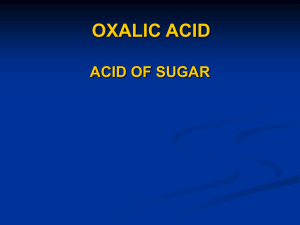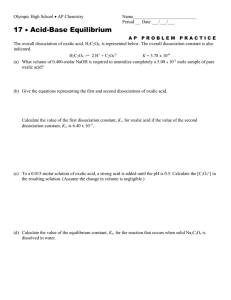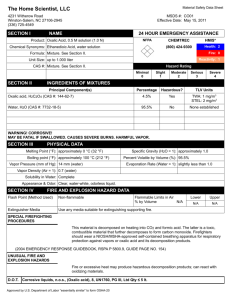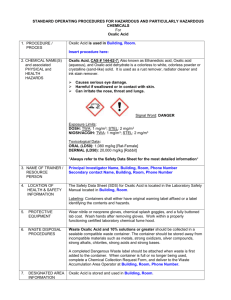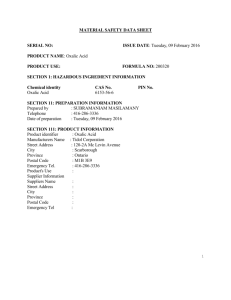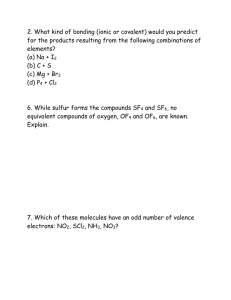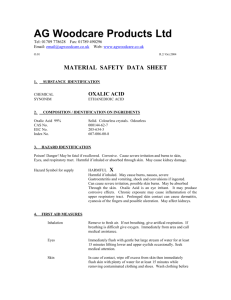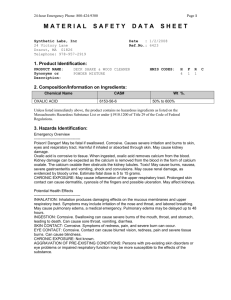oxalic acid safety sheet - Ontario Beekeepers` Association
advertisement
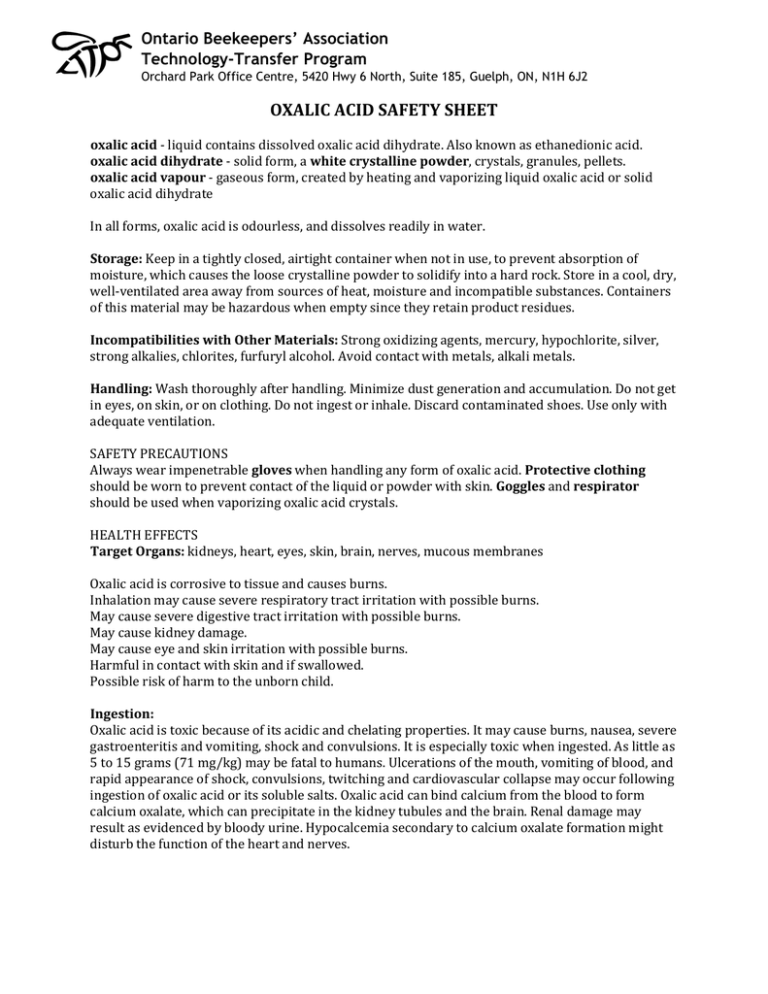
Ontario Beekeepers’ Association Technology-Transfer Program Orchard Park Office Centre, 5420 Hwy 6 North, Suite 185, Guelph, ON, N1H 6J2 OXALIC ACID SAFETY SHEET oxalic acid - liquid contains dissolved oxalic acid dihydrate. Also known as ethanedionic acid. oxalic acid dihydrate - solid form, a white crystalline powder, crystals, granules, pellets. oxalic acid vapour - gaseous form, created by heating and vaporizing liquid oxalic acid or solid oxalic acid dihydrate In all forms, oxalic acid is odourless, and dissolves readily in water. Storage: Keep in a tightly closed, airtight container when not in use, to prevent absorption of moisture, which causes the loose crystalline powder to solidify into a hard rock. Store in a cool, dry, well-ventilated area away from sources of heat, moisture and incompatible substances. Containers of this material may be hazardous when empty since they retain product residues. Incompatibilities with Other Materials: Strong oxidizing agents, mercury, hypochlorite, silver, strong alkalies, chlorites, furfuryl alcohol. Avoid contact with metals, alkali metals. Handling: Wash thoroughly after handling. Minimize dust generation and accumulation. Do not get in eyes, on skin, or on clothing. Do not ingest or inhale. Discard contaminated shoes. Use only with adequate ventilation. SAFETY PRECAUTIONS Always wear impenetrable gloves when handling any form of oxalic acid. Protective clothing should be worn to prevent contact of the liquid or powder with skin. Goggles and respirator should be used when vaporizing oxalic acid crystals. HEALTH EFFECTS Target Organs: kidneys, heart, eyes, skin, brain, nerves, mucous membranes Oxalic acid is corrosive to tissue and causes burns. Inhalation may cause severe respiratory tract irritation with possible burns. May cause severe digestive tract irritation with possible burns. May cause kidney damage. May cause eye and skin irritation with possible burns. Harmful in contact with skin and if swallowed. Possible risk of harm to the unborn child. Ingestion: Oxalic acid is toxic because of its acidic and chelating properties. It may cause burns, nausea, severe gastroenteritis and vomiting, shock and convulsions. It is especially toxic when ingested. As little as 5 to 15 grams (71 mg/kg) may be fatal to humans. Ulcerations of the mouth, vomiting of blood, and rapid appearance of shock, convulsions, twitching and cardiovascular collapse may occur following ingestion of oxalic acid or its soluble salts. Oxalic acid can bind calcium from the blood to form calcium oxalate, which can precipitate in the kidney tubules and the brain. Renal damage may result as evidenced by bloody urine. Hypocalcemia secondary to calcium oxalate formation might disturb the function of the heart and nerves. Ontario Beekeepers’ Association Technology-Transfer Program Orchard Park Office Centre, 5420 Hwy 6 North, Suite 185, Guelph, ON, N1H 6J2 Inhalation: Oxalic acid vapor is harmful if inhaled. It can cause severe irritation and burns of nose, throat, and respiratory tract. Inhalation of oxalic acid dust or vapor can also cause protein in the urine, nosebleed, ulceration of the mucous membranes, headache, nervousness, cough, vomiting, emaciation, back pain (due to kidney injury), and weakness. Skin Contact: Oxalic acid can cause severe skin irritation. The crystals/solution are harmful if absorbed through the skin. Rare chemical burns may occur from oxalic acid and may cause hypocalcemia. Gangrene has occurred in the hands of people working with oxalic acid solutions without rubber gloves. The skin lesions are characterized by cracking of the skin and the development of slow-healing ulcers. The skin may be bluish in color, and the nails brittle and yellow. Eye Contact: Oxalic acid may cause severe eye irritation. It may produce corrosive effects or result in corneal injury. Chronic Exposure: Inhalation of oxalic acid dust or mist over a long period of time might result in weight loss and respiratory tract inflammation. Rats administered oxalic acid at 2.5 and 5% in the diet for 70 days developed depressed thyroid function and weight loss. Prolonged skin contact can cause dermatitis, cyanosis of the fingers and possible ulceration. A study of railroad car cleaners in Norway who were heavily exposed to oxalic acid solutions and vapors revealed a 53% prevalence of urolithiasis (the formation of urinary stones), compared to a rate of 12% among unexposed workers from the same company. Aggravation of Pre-existing Conditions: Persons with pre-existing skin disorders or eye problems, or impaired kidney or respiratory function may be more susceptible to the effects of the substance. EMERGENCY OVERVIEW - What to do in an emergency situation with oxalic acid. Inhalation: If vapors are inhaled, move to fresh air. If the person in question is not breathing, provide artificial respiration. If breathing is difficult for the affected person, provide oxygen. Call a physician immediately. Ingestion: If oxalic acid crystals/solution is ingested, DO NOT INDUCE VOMITING! Give large quantities of limewater or milk to drink. Never give anything by mouth to an unconscious person, wash out mouth with water instead. Call a physician immediately. Skin Contact: In case of contact, wipe off excess from skin then immediately flush skin with plenty of water for at least 15 minutes while removing contaminated clothing and shoes. Wash clothing before reuse. Call a physician immediately. Eye Contact: Immediately flush eyes with gentle but large stream of water for at least 15 minutes, lifting lower and upper eyelids occasionally. Call a physician immediately.
